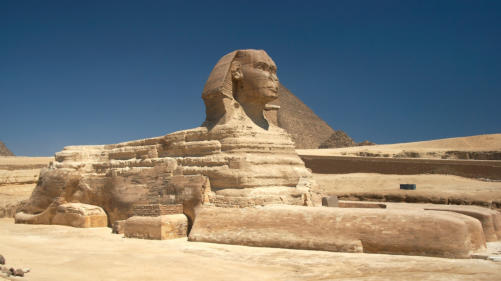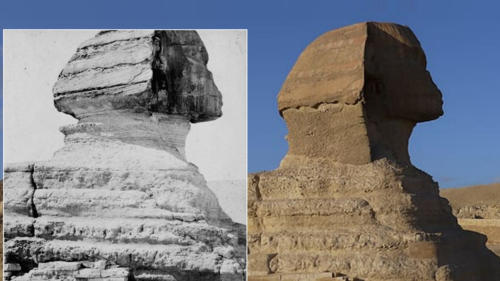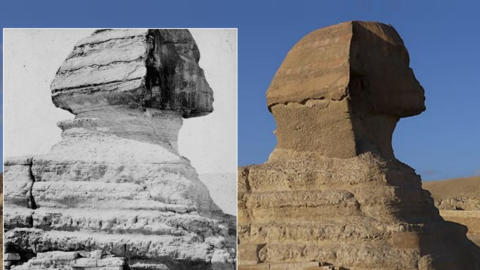


RobertSchneiker.com

The paradox of the Sphinx is that it is both the best
known and the least understood monument in Egypt.
For some inexplicable reason, the ancient Egyptians
never mention the Sphinx. The first known reference
comes some 1,100 years following construction in
1400 BC. Without evidence, even mainstream
archaeologists could not say for certain how old the
Sphinx is.
It was the claim of water erosion on the Sphinx that
started a debate between mainstream and
alternative archaeologists. First suggested in the
1950s by R. A. Schwaller de Lubicz, an alternative
Egyptologist, it was later popularized by author and
pseudoscientist John Anthony West. West loved to tell the story of how, after years of searching, he finally found Robert Schoch,
a geologist/geophysicist at Boston University. Picking up the story, Schoch describes how after traveling to Egypt it took only
seconds to conclude West was right: the Sphinx had been eroded by precipitation. To West, this was proof of a lost civilization.
Something he had first proposed many years earlier.
Together West and Schoch presented a paper on the age of the Sphinx at the Geological Society of America annual meeting in
1991. The prospect of and older Sphinx opened the floodgates on speculation about lost civilizations in the mainstream press.
Since then, the age of the Sphinx has become a hotly debated subject. Dueling versions of prehistory have emerged. The sudden
appearance of the ancient Egyptians in the Nile Valley 5,000 years ago seems to further validate the alternative archaeologists.
For mainstream archaeologists none of this made any sense. Alternative archaeologists took up where the scientists left off,
declaring scientists were either too naïve or to close-minded to understand. Or worse accused scientists of lying.
The belief that the Sphinx had undergone erosion was nothing new to the mainstream archaeologists. Their only question was
when and how. For them it was only the claim that erosion occurred more than 4,500 years ago that was the issue.
Even as the age of the Sphinx was being debated, geologists were gradually discovering the Sahara had been a green savanna
from about 12,000–5,500 years ago. Alternative archaeologists claimed this was evidence of the very precipitation that eroded
the Sphinx.
No one seemed to realize a Green Sahara proved exactly the opposite. Located within the Nile floodplain, the Sphinx is
intimately linked to the river. Increased precipitation during the African Humid Period produced extraordinary Nile River floods.
Sitting just meters above the Nile, the Sphinx would have been inundated by the Nile for at least part of the year. The Nile River
would have destroyed the Sphinx, or at the very least left a bathtub ring of erosion. The green Sahara proves that the Sphinx
cannot be more than 5,000 years old.
Although some of the details are outdated, Randall Carlson provides a good description of the Nile floods during the African
Humid Period on The Joe Rogan Experience Podcast.
The Big Question
This still does not answer the big question: why does the Sphinx appear eroded? Over the millennia, the Sphinx has been altered several times and for various reasons. A concrete patch at the neck put there in the 1920s conceals the greatest degree of what has been considered erosion. I now knew why the soft weathered limestone of the Sphinx body and neck was so susceptible to erosion. As a geologist, I also knew that whatever caused the erosion at the neck it was not precipitation. But I had no idea what type of geologic process could, or when that may have occurred. Somewhat out of frustration I decided to watch the episode of Nova that started it all again. I had forgotten about the segment where they attempted to carve a replica nose using traditional stone tools. For the most part ancient Egyptian carving was accomplished by pounding hard stones against the softer limestone. Combined with the knowledge that the softest limestone was exposed at the neck, I finally had my answer. After six years of research, I finally figured it out. The reality is there is very little erosion of any type on the Sphinx. What has been described as erosion was part of the construction process. In other words, both mainstream and alternative archaeologists were wrong. Neither side could win the debate as both sides had misinterpreted the evidence. By following the evidence over the past 40 million years, I was able to solve the riddle of the age of the Sphinx.





Water Erosion Hypothesis


Mysteries of the
Great Sphinx







© Robert Adam Schneiker 2023
RobertSchneiker.com

The paradox of the Sphinx is that it is both the best
known and the least understood monument in Egypt.
For some inexplicable reason, the ancient Egyptians
never mention the Sphinx. The first known reference
comes some 1,100 years following construction in
1400 BC. Without evidence, even mainstream
archaeologists could not say for certain how old the
Sphinx is.
It was the claim of water erosion on the Sphinx that
started a debate between mainstream and
alternative archaeologists. First suggested in the
1950s by R. A. Schwaller de Lubicz, an alternative
Egyptologist, it was later popularized by author and
pseudoscientist John Anthony West. West loved to
tell the story of how, after years of searching, he
finally found Robert Schoch, a geologist/geophysicist
at Boston University. Picking up the story, Schoch
describes how after traveling to Egypt it took only
seconds to conclude West was right: the Sphinx had
been eroded by precipitation. To West, this was
proof of a lost civilization. Something he had first
proposed many years earlier.
Together West and Schoch presented a paper on the
age of the Sphinx at the Geological Society of
America annual meeting in 1991. The prospect of
and older Sphinx opened the floodgates on
speculation about lost civilizations in the
mainstream press. Since then, the age of the Sphinx
has become a hotly debated subject. Dueling
versions of prehistory have emerged. The sudden
appearance of the ancient Egyptians in the Nile
Valley 5,000 years ago seems to further validate the
alternative archaeologists.
For mainstream archaeologists none of this made
any sense. Alternative archaeologists took up where
the scientists left off, declaring scientists were
either too naïve or to close-minded to understand.
Or worse accused scientists of lying.
The belief that the Sphinx had undergone erosion
was nothing new to the mainstream archaeologists.
Their only question was when and how. For them it
was only the claim that erosion occurred more than
4,500 years ago that was the issue.
Even as the age of the Sphinx was being debated,
geologists were gradually discovering the Sahara had
been a green savanna from about 12,000–5,500 years
ago. Alternative archaeologists claimed this was
evidence of the very precipitation that eroded the
Sphinx.
No one seemed to realize a Green Sahara proved
exactly the opposite. Located within the Nile
floodplain, the Sphinx is intimately linked to the
river. Increased precipitation during the African
Humid Period produced extraordinary Nile River
floods. Sitting just meters above the Nile, the Sphinx
would have been inundated by the Nile for at least
part of the year. The Nile River would have
destroyed the Sphinx, or at the very least left a
bathtub ring of erosion. The green Sahara proves
that the Sphinx cannot be more than 5,000 years
old.
Although some of the details are outdated, Randall
Carlson provides a good description of the Nile
floods during the African Humid Period on The Joe
Rogan Experience Podcast.
The Big Question
This still does not answer the big question: why does the Sphinx appear eroded? Over the millennia, the Sphinx has been altered several times and for various reasons. A concrete patch at the neck put there in the 1920s conceals the greatest degree of what has been considered erosion. I now knew why the soft weathered limestone of the Sphinx body and neck was so susceptible to erosion. As a geologist, I also knew that whatever caused the erosion at the neck it was not precipitation. But I had no idea what type of geologic process could, or when that may have occurred. Somewhat out of frustration I decided to watch the episode of Nova that started it all again. I had forgotten about the segment where they attempted to carve a replica nose using traditional stone tools. For the most part ancient Egyptian carving was accomplished by pounding hard stones against the softer limestone. Combined with the knowledge that the softest limestone was exposed at the neck, I finally had my answer. After six years of research, I finally figured it out. The reality is there is very little erosion of any type on the Sphinx. What has been described as erosion was part of the construction process. In other words, both mainstream and alternative archaeologists were wrong. Neither side could win the debate as both sides had misinterpreted the evidence. By following the evidence over the past 40 million years, I was able to solve the riddle of the age of the Sphinx.




Water Erosion Hypothesis

Mysteries of the
Great Sphinx


























